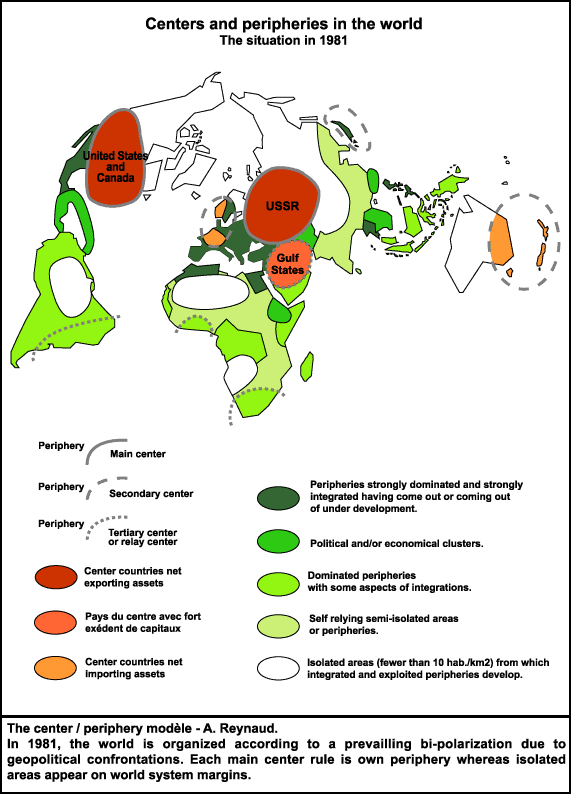Periphery
From Geography
Definition
Peripheria is an old Greek term that is used to describe the outside. In geographical terms we usually speak about the periphery in contexts of cities and regions. The periphery is usually the lesser developed part of a town or region, that is usually located at the edge of the cities/regions and far away from the developed, more "sophisticated" and often beautiful city/regional centre. Periphery is an important term in geography and we can find this term in a lot of theories like the Central Place Theory of Christaller (1966) and other theories that involve spatial (inter)action.
Example centre-periphery relation [1]
Different scale levels. When we use the geographic term of periphery we can look at this term at different scale-levels.
City-Level
We can look at this definition on a city perspective. An example is that the neighborhoods at the edges of cities are usually less beautiful and developed than the city centres. The less developed areas are called periphery and the city centres are called centre. Peripherical areas usually are characterized by poverty, criminality and possibly environmentally poverty.
International Level
We can also look at this term at a bigger scale level. Countries for example also have a centre and a periphery. In the Netherlands 'de Randstad' can be seen as the (economic) centre of the country while for example the provinces of Drenthe, Zeeland and Limburg can be seen as the periphery because of the lower (economic) activity. The centre/periphery distinction could also be used at a world scale. In this case "The West" is the centre and (parts of) Africa, Latin America and Asia are periphery.
How can we decide about the border between centre and periphery? What makes places periphery and why aren't activities concentrated in periphery areas, but are they concentrated in centres? The concept of centrality is giving an answer at this question in the Central Place Theory which states that a central place is a geographic location where services and goods are provided for a surrounding area. This way of thinking means that the periphery is dependent on the centre. The dependent area is also referred to as "catchment area".
Conclusion
Periphery is an important term within the field of human geography. A lot of theories from very influential scientists use this term and build theories around it. Therefore it is nescessery for every human geographer to know and understand what this term means. The contrary term to periphery is centre. The centre is the core area of a region, where most (social, economic or other) activity takes place.
So when speaking about centre or periphery, it is always a comparison between two or more areas. You can't define a periphery when you don't know anything about a centre/central area.
References
- Christaller, W. (1933). Die zentralen Orte in Süddeutschland. Translated by Baskin, C. (1966) as Central Places in Southern Germany. Prentice Hall.
Contributors
- Page created by Jan-Peter Hoste s4026349 - ...
- Page enhanced by Robert Wursten - October 10th 2012
- Page enhanced by Marleen Revenberg on October 17th 2012
- Page enhanced by TeunVanDeVen - 11:30, 24th October 2012 (CEST)
- Page enhanced and links added by Kasper van de Langenberg on December 30th 2012
